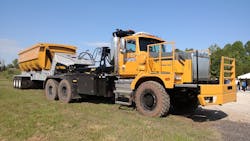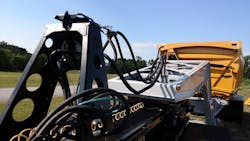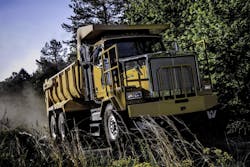Off-road earthmoving equipment is bigger and heavier than normal vocational trucks, and I expect that. Still, I was rather wowed at the sight of the rig you see here: A Western Star 6900XD hitched to a Smithco 85-Metric-Ton Gooseneck Tipper, among the products recently displayed by Western Star Trucks and suppliers at the Michelin Proving Grounds in South Carolina. This event was mainly for customers and dealers; I was the lone writer, so tried to blend in.
Western Star showed off its line of off-road vehicles for mines, quarries, and heavy construction sites. It offers 40- and 25-ton dump trucks with integrated steel bodies that compete with haul trucks from Caterpillar, Komatsu, Terex, and others. Its argument is that something more akin to a highway truck, albeit outfitted with extreme-duty mainframes, axles, suspensions, and other components, can do a more economical job of carrying rock, ore, and other commodities than the more specialized vehicles.
Western Star’s marketing segment manager, Peter Schimunek, briefed us on the XD series. He said the 6900XD and 4900XD cost less to buy and maintain than haul trucks with comparable capacities, and are easier on fuel. They can travel faster and, depending on distance, can haul extra loads in a shift and are therefore more productive. They are at their best on lengthy runs over graded gravel and dirt roads.
But haul trucks can more ably take rough ground and walk over tall obstructions that would stall the ’Stars, remarked an attendee, a Georgia quarry operator who said he runs a group of Deere haulers. He shrugged off the idea of trucks like these replacing his Deeres. But he was curious enough to climb onto a ’Star’s steel fender, open the hood’s panels, and peer inside the engine compartment to examine how maintenance items were laid out around the engine. He seemed satisfied at what he saw. The rugged, walk-on fenders and butterfly hood are standard with an XD, and the safety railings satisfy workplace requirements.
Hook-lift systems
Hook-lift systems are not new, and I recall writing about them in the 1980s (Palfinger currently offers many models of its own). But those are comparatively small, on-highway products, while Carco’s MBT-40 is capable of lifting and supporting much larger and heavier bodies, and therefore loads. Its latest body is a fifth-wheel kit that includes a subframe on which the coupling device is mounted. That raises the fifth wheel’s height by more than a foot, and the Smithco trailer’s gooseneck is correspondingly taller than usual. Partly because of a higher center of gravity, this trailer’s capacity of 85 metric tons is less than the 100 metric tons it would otherwise be rated for, said Smithco’s national sales manager, Rick Lawrence. The trade-off is versatility.
For the demonstrations, a big Caterpillar wheel loader filled the trailer’s tub to the gills with gravel, and when the rig returned from a demo run (I took several extra turns), attendees watched as the tub tipped to its left, spilling the gravel onto the ground. Western Star reps said rigs like this—though with standard-height fifth wheels and larger-capacity trailers—are operating at mines in northeastern Canada and in central Australia.
The Western Star-Smithco rig was a handful to drive, not so much because of its size (126 inches wide and about 70 feet long) or weight (about 250,000 pounds gross), but its stiff power steering. As you’d expect, a twin-gear setup, in this case from TRW, is needed to manipulate the beefy 28,000-pound, planetary geared, front-driving axle, and I needed two hands on the wheel to make all turns. And the wheel didn’t automatically center; I had to twist it to return it to a straight-ahead position.
A Detroit DD16 provided enough horses to get the rig up to 45 mph on a three-quarter-mile stretch of gravel, and yes, I had to put my foot into it. A 7-speed Allison automatic transmission did all the shifting, taking away much of the work of driving. The Allison’s keypad selector let me downshift to raise revs and let the engine brake supply more retarding power. In full-on mode, I modulated the retarder with the accelerator—touch it and the brake switched off, let up and the brake was back on. For the most part, the tranny works fine on its own, and up- and downshifted appropriately.
The Michelin facility’s off-road course includes straight gravel roads with partially paved turn-around loops, plus a 9 percent downgrade on asphalt and similarly steep ascents. One of the climbs is on a gravelly surface and the other on a rutted dirt and rock trail. The ruts were more fun, and made more than bearable by an effective air-ride seat. The burly rig was satisfying to drive because of a sense of really getting something done. Also on the premises was a regular 6900XD 40-ton dump, a model that I drove and wrote about in 2009, so I didn’t drive it this time (See “Western Star 6900XD Proves a Real Rocker,” November 2009).
A smaller XD
The smaller 4900XD 25-ton dump, also called XD25 Off-Road, was introduced earlier this year, and this event was one of the first opportunities to drive it. It’s a ruggedized version of the road-going 4900 with a setback steer axle. Although it drove much like its lesser brothers, the XD’s frame is triple-channeled, its Meritor steer axle is rated for 22,000 pounds, its Sisu tandem rears are built to take 70,000 pounds, and they ride on steel-spring suspensions with similar capacities. So its cab sits higher and takes a bit more effort to climb into. But otherwise it was a matter of punching D on the Allison transmission’s selector pad, releasing the parking brakes, and stepping on the accelerator. The strong Detroit Series 60 bellowed as we moved out and burbled when its retarder took hold. That wonderful sound caused me to drive this and other Series 60-powered trucks as often as I could.
Western Star’s argument for the 25-ton dumper is similar to that for the 40-tonner: lower price than a haul truck, greater productivity, better fuel economy, and easier maintenance because components are more accessible and generally easier to handle than those of a haul truck. An XD25 can’t do everything a haul truck can, but when placed in the right type of service—longer runs on decently maintained roads and trails—it constitutes a compelling case to acquire for a hauling job.







